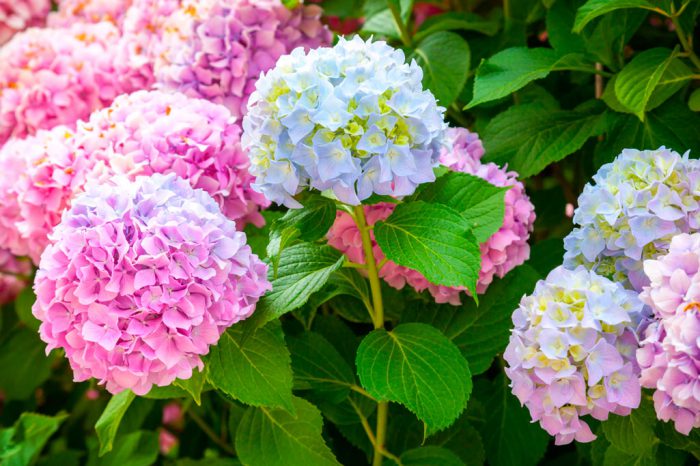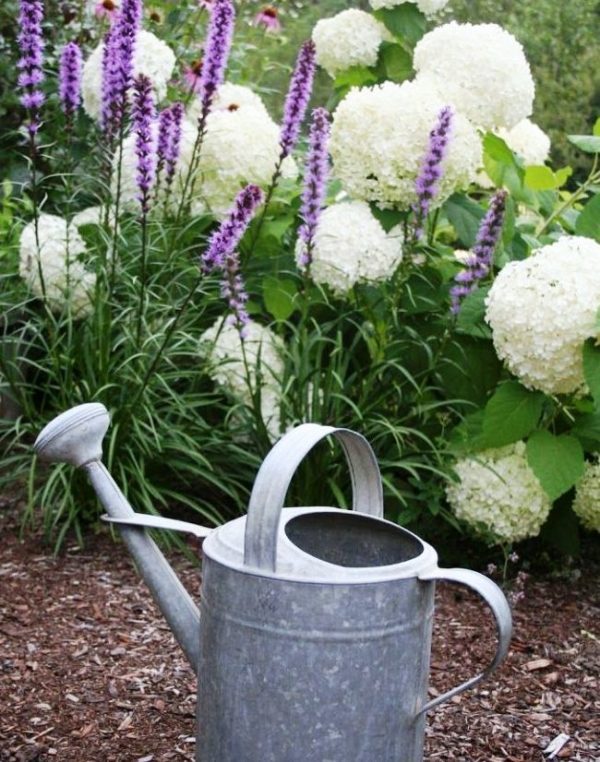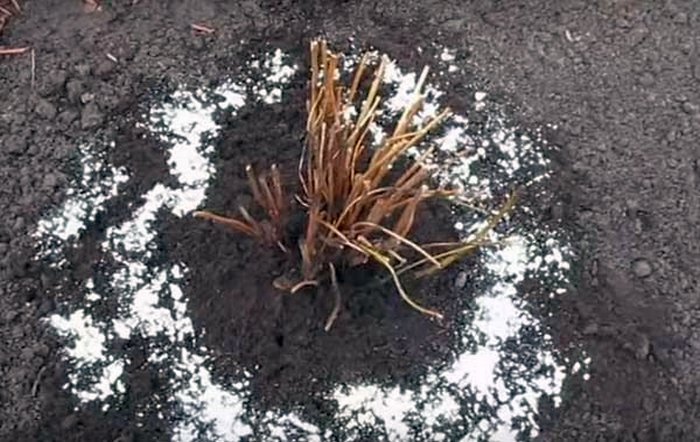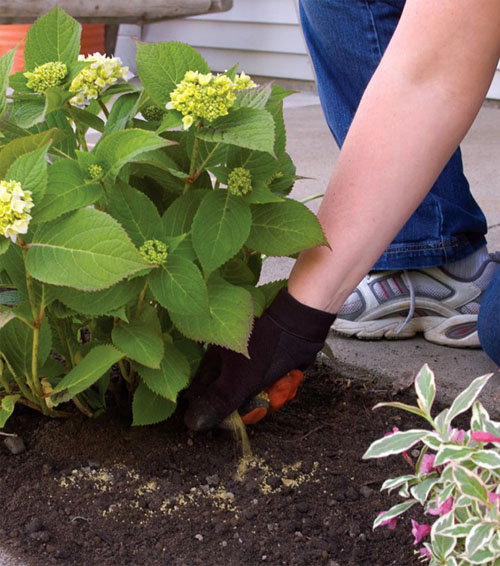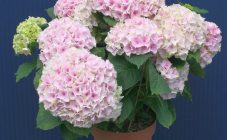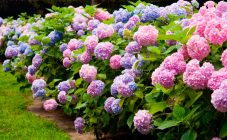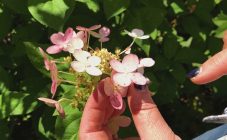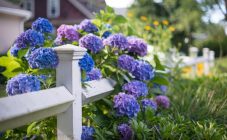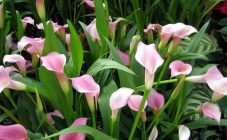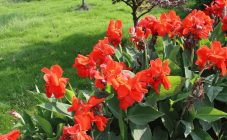Content:
Hydrangea is an amazing plant, a bright green shrub with large inflorescences of different colors (pink, blue, lilac). The shrub grows up to 1.5-3 meters in height, loves water, moist air and coolness. Most often grown in the garden, but home cultivation also takes place.
The main types of hydrangea: tree, oak-leaved, large-leaved, paniculate, serrate, petiolate, Sargent and Bretschneider. Each type of plant includes several varieties, unique in their own way, in total, more than 50 species of hydrangea are known.
Hydrangea in the garden
Hydrangea in the garden is an incredibly beautiful and delicate plant, and like everyone else, it needs care and attention. In order for the hydrangea to fully grow and bloom on time, the care must be correct, it is necessary to provide the plant with:
- acidic moisture-consuming soil;
- semi-shaded area;
- abundant systematic watering;
- competent timely pruning;
- preparation for wintering.
In the garden, hydrangeas are provided with a suitable site, depending on the variety:
- paniculate varieties are distinguished by fragile shoots, in order to protect them from snow falling from the roofs, they are placed icicles away from buildings;
- petiole varieties require support, so it is convenient to plant them near the walls of a garden house, fences, gazebos;
- most of the varieties prefer free places with openwork penumbra.
Plant care
It is preferable to plant hydrangea in open ground in the spring, in the southern regions of Russia it is possible in the fall. The planting pit is prepared on average 40 cm in diameter and up to 50 cm deep, depending on the size of the seedling root system. Prepared soil from two parts of humus and the same amount of leafy soil, one part of peat crumbs and river sand, are introduced into a dug hole and form a small mound. A hydrangea seedling is carefully fixed on the made tubercle, the root system is straightened and covered with soil, while the root collar is at ground level. The soil in the near-trunk circle is well compacted, the hydrangea is watered.
To prevent the plant from withering, you need to know how to care for a hydrangea in the country, in the garden after planting.
Watering and moisture
Hydrangea is a fairly moisture-loving plant, which means that the root system and soil in the trunk circle must always be moistened. To do this, it is worth regularly watering the bushes and mulching. For mulch, shavings, needles, chips, leaf humus are used.
There is practically no need to worry about the indicators of air humidity for garden hydrangea, since nature provides an optimal level for the plant, with the exception of a very hot, dry summer, in which you need to spray the bushes with water.
Top dressing and mulching
To retain moisture, as well as to prevent weeds, the trunk circle must be mulched. It also protects hydrangea roots from overheating. Peat chips, wood chips or bark, which have an 8-10 centimeter layer, are excellent for mulch.
Hydrangea feeding is carried out several times per season: the first time - when planting, then - at the end of May or early June, the next - every 3 weeks.
Use a solution of mullein, chicken droppings, in proportions of 1:10.Superphosphate, potassium sulfur and urea are suitable as mineral supplements. The last feeding of the plant is carried out until the end of July, in August there should no longer be any fertilizers, since the shoots of the hydrangea need to have time to lignify by winter.
During flowering, hydrangea is treated with "Kemira floral", it promotes active blooming and long flowering.
A weak solution of potassium permanganate is used for strong and flexible shoots. Garden stores sell special complex fertilizers for hydrangeas, which contain all the substances necessary for the plant.
Pruning hydrangea
Pruning of the plant takes place in the autumn period or in the spring, preferably autumn is chosen, since the process of sap flow slows down significantly, and the cutting process will favor the lush flowering of hydrangea in spring. Pruning in spring can impair the growth and flowering process, in addition, sap will be intensively released from the wounds. If there is an urgent need to prune in the spring, then it is carried out until the buds swell.
Hydrangea pruning is carried out in accordance with the varietal characteristics:
- ¾ in large-leaved, prickly, serrated, liana-shaped, oakleaf and Sargent's hydrangea, pruning is carried out for the reason that they only have flowers on the shoots of the second year, and weak and old branches are removed to strong buds;
- ¾ old, weak and faded shoots are cut off in tree and paniculate shoots, while a large number of shoots are not removed, since these types of hydrangea are very difficult to tolerate such manipulations.
Pruning hydrangeas for the winter means removing dry, painful shoots, it is better not to touch young seedlings at all - the plant may freeze.
For 4 or 5 years, the hydrangea is updated, since it has already ceased to bloom.
Growing hydrangeas at home
Those who want to acquire a room hydrangea are often interested in the question of how to care for a hydrangea at home. Caring for a hydrangea at home is not difficult at all. The plant is guaranteed regular abundant watering, which it needs most during the growing season, and daily spraying (fine spray). Temperature conditions are 20-22 ° C, and in winter - at least 9-10 degrees. On warm days, a pot with a house plant is taken out into the street, almost until autumn, until all the leaves fall off. Then the plant is brought into a dark place and try not to disturb it for 90 days, with the exception of moderate watering.
At the end of winter, the hydrangea is transplanted into a new fertile soil, damaged, dry stems are cut off. Breeding indoor hydrangeas is no different from plants on the street.
Diseases and pests
At home, hydrangea becomes a tasty morsel for aphids, spider mites and stem nematodes. Against the first two, spraying with water and wiping with soapy water are used, in more advanced cases Actellik is used. Unfortunately, the plant cannot be saved from the nematode.
Of the diseases, the plant is most often exposed to powdery mildew, gray rot and chlorosis. To get rid of powdery mildew, use a mixture of copper sulfate (15 g) and soap dissolved in water. Bordeaux liquid is used against gray rot, and watering with a solution of ferrous sulfate (for 1 liter of water 10 g of substance) helps against chlorosis.
Reproduction by root suckers
You can grow a hydrangea from seed by dividing the bush and cutting. The plant reproduces very well by root suckers. Offspring, or shoots, is a young shoot extending from the root, which, during growth, forms its own root system.
The offspring, along with the resulting roots, are carefully dug out without harming the mother bush. Transplanted to another place and take care of it as a full-fledged plant.
The specifics of care and cultivation in the Moscow region
Growing and caring for hydrangeas in the Moscow region is not particularly difficult. The only thing – more heat-loving plant varieties will need preparation for the winter:
- Ö starting from the second decade of September, all lower leaves are cut off;
- Ö wrap the bush with burlap, lutrasil;
- Ö with the onset of frost, the bush is tied up, bent to the ground on pre-prepared spruce branches or sawdust;
- Ö the roots are covered with rotted manure, leaves or needles from above, and spruce branches are applied again, then the snow that falls will serve as an additional “blanket”.
In other respects, the process of growing and looking after the plant is similar.
Experienced gardeners recommend:
- stop watering the plant in early September;
- remove all lower leaves;
- do not allow the removal of the apical bud of the plant;
- do not cut the blackened shoots (perhaps they are still alive, which will be clear in the spring), and there is no need to cut the plant before winter, with the exception of weak, broken shoots;
- do not remove the faded hydrangea inflorescences so that they provide the buds with additional protection from frost.
In the Northwestern regions, Siberia and the Urals, where temperatures can drop to -40 ° C, it is better to grow hydrangea tree varieties, but careful shelter for the winter will also be required.
Proper care will give you the opportunity to admire the unrealistically beautiful hydrangea flowers all summer, and at home you will be able to enjoy the plant all year round.
